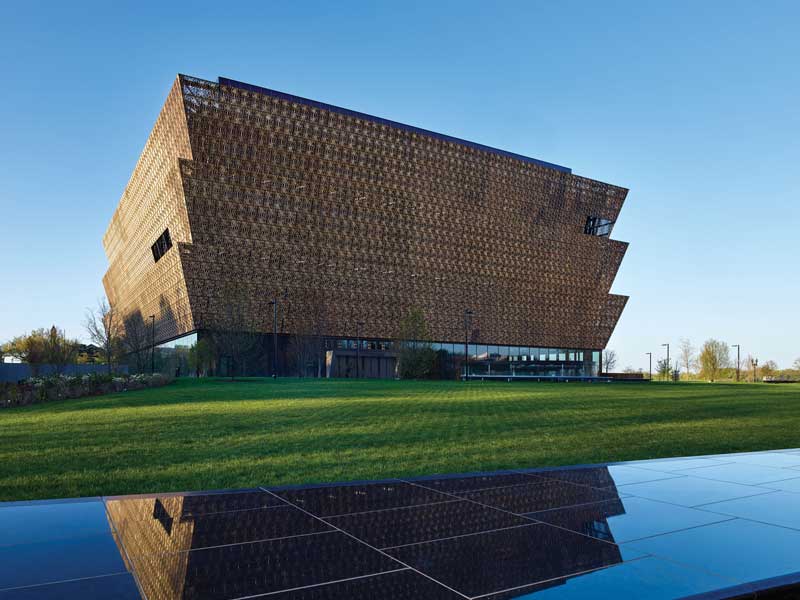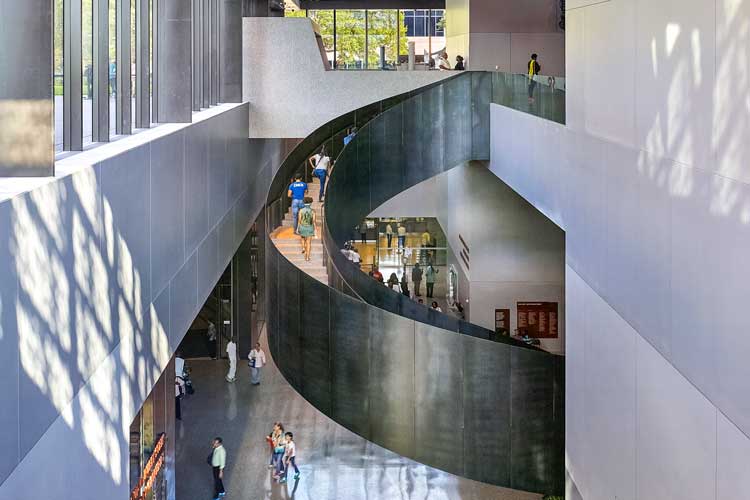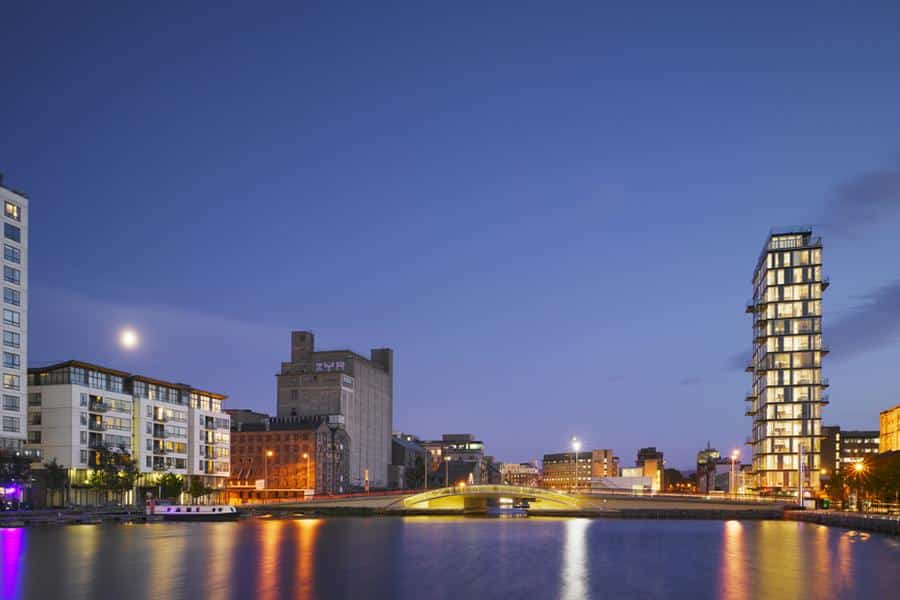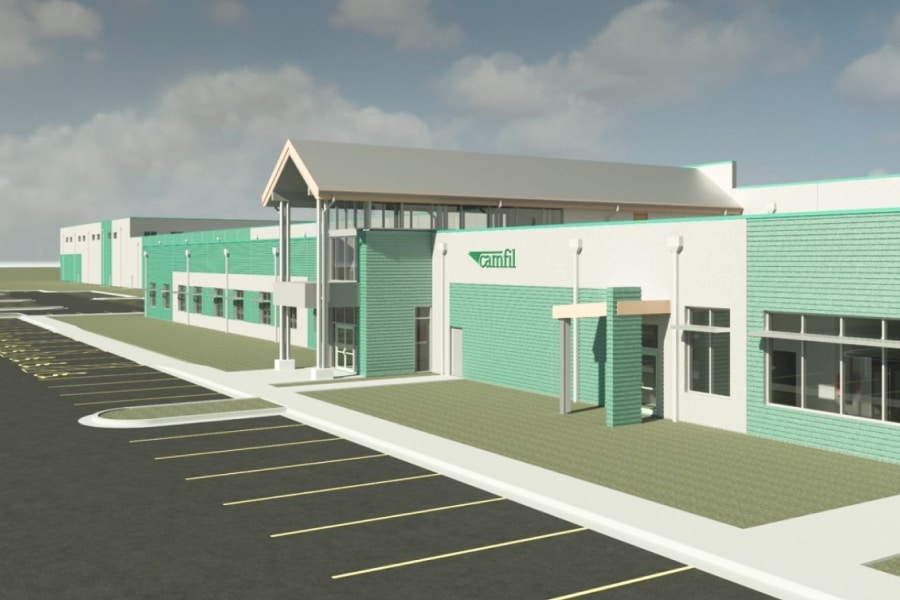In brief:
- NMAAHC opened in 2016; Phil Freelon was lead architect
- The museum celebrates and reflects African American history in its mission and its design
- Restrictive zoning laws on the National Mall forced the architects to expand below-grade plans
- A monumental spiral stair takes visitors from grade to lower levels, creating a unique entrance experience
The Smithsonian National Museum of African American History and Culture (NMAAHC) opened in 2016, to much fanfare over its mission as well as its striking architecture. The building, which occupies the last open site on the National Mall in Washington, D.C., is situated between Washington Monument to the southwest and the Smithsonian Museum of American History to the east. After hundreds of architectural firms were invited to submit a design for the museum in 2008, the collaboration group working under the name of Freelon Adjaye Bond/SmithGroup JJR was chosen. Phil Freelon, who was lead architect on the project, joined Perkins+Will as design director of their North Carolina offices in 2014. Freelon is known as one of the foremost practitioners of civic and cultural architecture in the country.
The building site posed several challenges: zoning laws prohibited building high enough above ground to provide ample space for the museum’s program; thus, today, there are five stories above, and five stories below ground. Visitors enter at grade, so the architects wanted to ensure that people didn’t simply ignore the bottom floors. The design team conceived of a unique staircase that carries visitors down to the lower levels—a journey that some have interpreted as mirroring the African slave experience of arriving to this country in Eastern ports and immediately descending into a metaphoric underground of enslavement. The visitor’s path from below ground to the museum’s light-filled top levels symbolizes all that African Americans have achieved in the US since then.
The monumental spiral stair is an elliptical helix, twisting 270 degrees as it makes its way to the landing. Though strikingly minimalist in appearance, it was an incredibly difficult structure to design, requiring complicated steelwork, an exacting search for suitable materials, and extensive virtual modeling.
Built reached out to Zena Howard, principal at Perkins+Will and project manager on NMAAHC, and Todd Case, senior associate there, who was also involved in the museum’s design, about their work on the NMAAHC. Howard and Case answered some of our questions.
Built Blog: Our memorials and museums are a reflection of our society. What did you want the NMAAHC to say about America?
Howard: In the words of Lonnie Bunch, the founding director of the museum, “The African American experience is the lens through which we understand what it is to be an American.” The museum is a manifestation of this lens in many ways; it serves to help the public understand the African American experience and physically focuses the visitor on that history and culture which envelops the building.
Built Blog: About African American history in America?
Howard: Relative to physical context, the NMAAHC is distinct in form, materiality and color from its neighboring buildings on and near the National Mall. While these characteristics afford a particular prominence, the overall building remains respectful in its alignments and restraint in scale, proportion and visibility. We believe this reflects the physical and cultural distinction of African Americans and how collectively this people have proudly defined and contributed to the very tapestry of the America we know today.
Built Blog: And what, more specifically, did you want the monumental staircase to symbolize?
Howard: The stair is designed to be an organic sculptural element in an otherwise rectilinear building; this contrast to the overall building along with its scale draws the visitors’ attention immediately. Although the form was not directly derived from any specific historic reference, some see it as a metaphor for the African diaspora suggesting the organic spreading of cultural influence, while others see it as an insertion of a more feminine form into the more rigorous overall geometry. The speculation as to the intent has been one of the best aspects—as with most art, it is in what the visitor brings to it and not necessarily the intent.
Built Blog: How did the design team approach the museum with the idea?
Howard: In coordination with various stakeholder groups, the design team and the Smithsonian determined that more of the building should be located below grade than what was originally envisioned in our competition submission. Therefore, we revised our design to relocate some of the main public areas to these lower levels (most of which did not require natural light, such as the main theater). It was important that a direct, simple path and flow be provided to facilitate movement of many people from the main central hall to these prominent lower areas. The monumental staircase was a gracious and elegant solution that was well-received by the Smithsonian.
Built Blog: Can you tell me how the visitors flow through the building and how the staircase facilitates that?
Howard: Given the strict height limits for buildings in Washington, D.C., and the number of artifacts and exhibits planned for the museum, a significant portion of the building is constructed below grade. From the National Mall you see a five-story museum but, upon arrival, visitors will discover another five stories, including three stories of exhibits, below grade.
Visitors enter the museum and descend into the history galleries where they begin their journey up through time. The monumental stair is located at a pivotal point in the visitor’s experience and navigation of the museum because visitors will experience it twice in the natural navigation of the museum:
The visitors first experience the stair as they begin their descent to the history galleries. The monumental stair connects the main entry level to the floor of the north atrium, which serves as the circulation spine for all of the galleries. From here, visitors enter the history gallery and ascend up through nearly 400 years of history.
The visitors’ second experience of the stair is when they exit the history gallery into the light-filled atrium and travel up to the Culture and Community galleries above grade.
Built Blog: Describe the process of working together with the museum generally, and if you can, the process of designing the staircase specifically. What kind of back and forth was there?
Howard: While the stair is a highly sculptural element, it also serves as an exit path and is a required means of emergency egress from the building. Therefore, we worked closely with the museum to meet all of the code requirements while maintaining the artistic integrity. To meet the code requirements, the stair needed to be properly illuminated and meet all of the required dimensions for clearances and landings. We carefully designed the steel side panels so that we maintained a continuous curve along the descent, which conceals the locations of the required landings. We also integrated concealed lighting in the handrail to gently light the stairs without introducing unwanted ambient light. This integrated lighting is contained within the steel side panels and enhances the experience of ascending or descending the stair.
Built Blog: Have you witnessed, overheard, or talked to visitors as they experience the grand staircase? If so, what are some of the most memorable things you’ve heard people say about/how they reacted to it/etc.?
Howard: Many of us have experienced great delight in watching children bound up and down the staircase. The stair is an easy way to facilitate the movement of busloads of students to the lower level. The students are often very excited by circulating vertically in a spiral pattern.
Built Blog: Finally, can you tell me how technology allowed you to create the staircase? What types of technologies were used to design it? To build it? What were some of the challenges of building a structure as complicated architecturally as this?
Howard: Given the prominence and complexity of the stair, accurate 3D modeling was essential for communication among the design team, with the owner and with the contractor. A number of different programs were used throughout the design process to render realistic views that helped all parties appreciate the form and massing of the stair within the space. Revit was used to fully model and document the stair and three-dimensional views were included in our construction documents to help the contractors better understand the design intent. The contractors used our models to start their documentation and facilitate their detailing and fabrication efforts.












